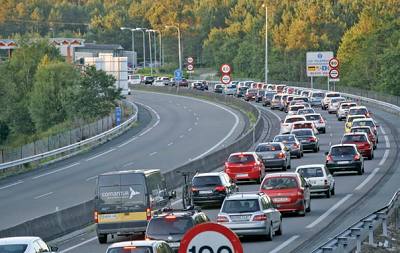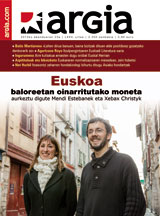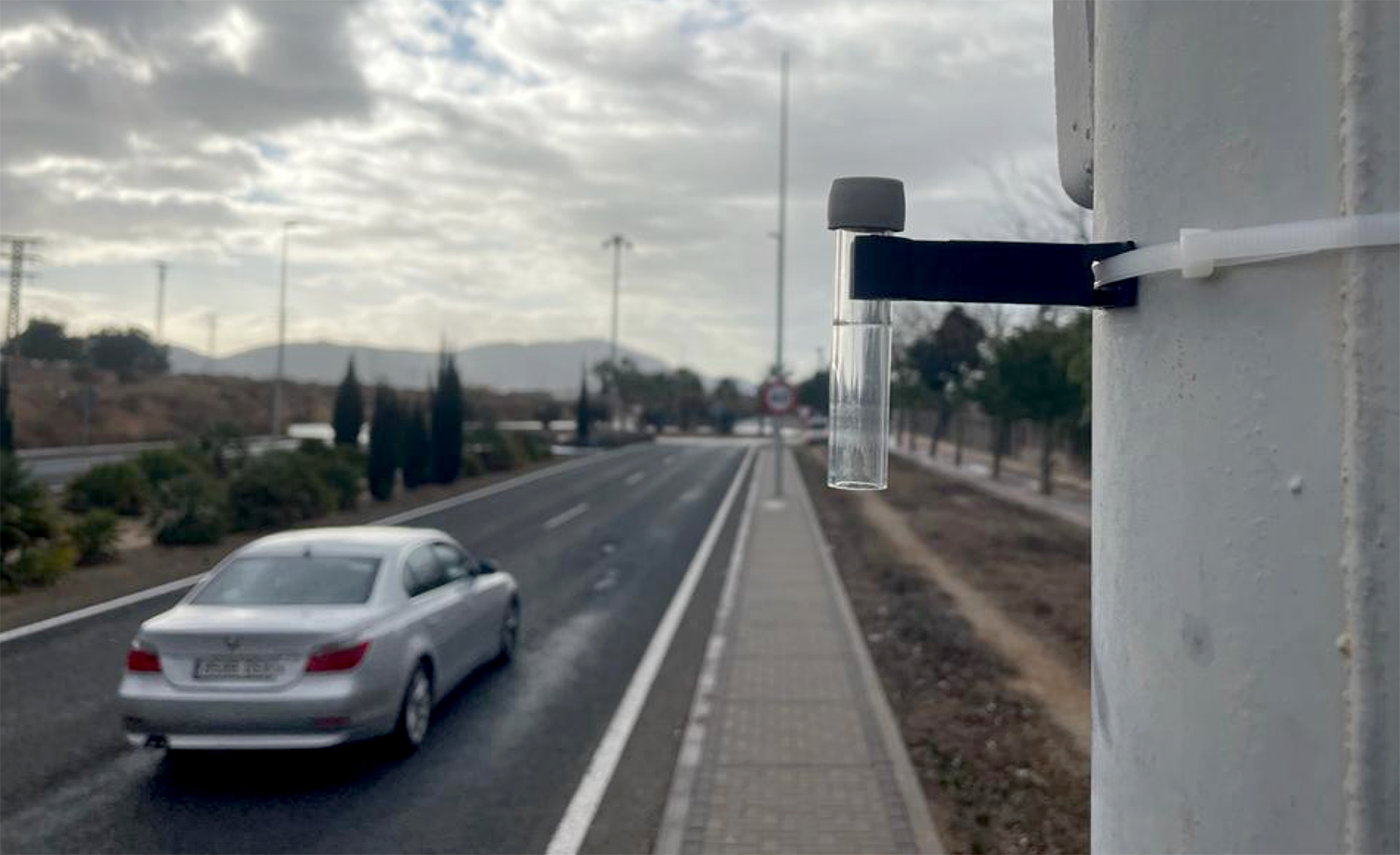The air we breathe, as polluted as legal
- We have known for a long time that air pollution affects our health, and the more we know, the more it becomes clear that these damage is even more serious than we thought. However, the legislation in force in the European Union and, consequently, in the Basque Country, does not take sufficient account of the scientific evidence, but of the interests of pollutants.

The inhabitants of Hego Euskal Herria have learned well the motto that remind us from time to time our institutions: the quality of the air we breathe is good. Look, for example, at Ihobe, the CAPV’s public environmental society, on 10 October this year: “The air quality in the Basque Country is good and you can breathe peacefully.” How can you marry that with the title given to it by the Catalan newspaper La Vanguardia two weeks earlier? “A report shows that inhaling European air shortens life.” The air we introduce into the Basque Country into the lungs is not European, right? Or do the authors of the report cited by La Vanguardia lie? Neither one thing nor another, the answer is simpler: our public institutions say “good-quality air” when they should say “air of the law”.
The European Union intends to make changes to air quality legislation for next year, but it is currently included in Directive 2008/50/EC which pollutants are to be measured, which are the maximum values for these substances and from what date their exceedance will be prohibited. This directive is the sum of the other five drafted since the mid-1990s and, in the opinion of Ekologistak Martxan, “it is a great setback, as some of the maximum values it sets are higher than those recommended by the World Health Organization and, worse still, than those established by the pre-existing legislation”.
Ekologistak Martxan published the report Air Quality in the Spanish State in early October 2011, with a worrying conclusion: 94 per cent of the State ' s population breathes contaminated air. According to one of the authors of the report, Paco Segura, the negative data is repeated year after year, but it is not remedied. On the contrary, the situation has worsened in believing the conclusions of the last three reports prepared by Ekologistak Martxan: In 2009, 79% of the Spanish population breathed poor air quality, compared to 90% in 2010.
European legislation takes into account a large number of pollutants, but the 2011 Spanish State Air Quality Report only collects data on five of them. They're the five most widespread. They do so effectively, according to Segura; if all substances are mentioned, the report would be an incomprehensible confusion. “We are therefore talking about the most problematic of them. Others only give bad values in certain places.”
These five substances are nitrogen dioxide (NO2), sulphur dioxide (SO2), tropospheric ozone (O3) and PM10 and PM2.5 particles. Except for the former, the maximum values permitted by Directive 2008/50/EC are higher than those recommended by the WHO. “The same is true for almost all substances,” explains Paco Segura, “one of the first limits that was established was the NO2 limit in 2001 and that was applied according to WHO recommendations. But they realized that this made it difficult to comply with the legislation, and since then they have placed ever wider limits that less protect the health of citizens.” In the table on the next page you can see the difference between the legislation of the European Union and that recommended by the WHO.
Health protection is not a priority
The report by Ekologistak Martxan stresses that European legislation defines the limit value for a substance as: “Maximum level established on the basis of scientific knowledge, in order to prevent, prevent or reduce damage to human health and the environment.” Considering that knowledge of science is mainly reflected in studies conducted at the request of the WHO, it is clear that there is an excessive gap between theory and practice.
Perhaps the most representative example is PM particles: For PM10, under 10 microns and above 2.5 microns, the previous legislation (1999) provided for two deadlines, one from 2005, the second from 2010. In the first term, the average annual value could not exceed 40 micrograms per cubic meter. In addition, there was a daily limit value of 50 micrograms, which could not be exceeded by more than 35 times a year. In the second term, conditions had to be much stricter, in line with WHO recommendations: the annual average would be halved (20 micrograms per cubic metre), and the 50 micrograms per day limit could not be exceeded by more than seven times a year, i.e. five times less than in the first phase. Finally, Directive 2008/50/EC maintained for the second the same values as for the first instalment.
“They seem to want to seek a balance,” says Paco Segura, “on one side is health protection and on the other is the pressure exerted by some governments and companies.” The latter would be at the limit of not having to take excessively harsh measures, so that the values laid down by law. The member of Ekologistak Martxan wishes to recall the enormous pressure capacity of industrial lobbies in the European Union.
PM2.5, the most dangerous
Numerous studies published in recent years indicate that PM particles are the most harmful in air pollutants, except dioxins, furans... emitting certain types of industries. And in them, PM2.5 particles, that is, those that have less than 2.5 microns, are the ones that present the highest risk. Their small size makes them more dangerous: in many cases they can pass directly into the blood, as the lungs cannot filter.
Despite this, PM2.5 has come late into legislation, to put it mildly. In fact, scientific knowledge of these substances is not as old as that of other substances. Their concerns have been reinforced by the fact that air quality measurement stations, on the one hand, are the least measured substance and, on the other hand, that there are still no limit values in force in the EU. This will require waiting until 2015, and as expected, the conditions laid down by law will not be particularly harsh: the average annual value will be 25 micrograms per cubic meter, while the WHO recommends not exceeding 10 micrograms. The difference is very pronounced.
Data from Hego Euskal Herria, above WHO recommendations
The 2011 Spanish State Air Quality Report collects data on the five substances mentioned above, taken directly from the air quality measurement stations of the autonomous communities. Regarding the data from the 77 measurement points of Hego Euskal Herria, it is observed that in 2011 the limits established by law were exceeded nine times. Among them, it should be noted that in the Zumarraga cabin, the quantities of PM10 above the permitted values have been measured 61 times, remembering that the number of days exceeded cannot exceed 35 in the same year. It is also noteworthy that in four stations in Navarra the maximum values of the tropospheric O3 were exceeded... and in all of Navarre there were only nine stations in 2011.
Everyone will know where their level of demand is, but it does not seem to be a fact that can alarm nine legal infringements. In this regard, we can see fit for our air advocates to regularly disseminate reassuring messages. However, the accounts vary greatly if the glasses are removed from the legislation and the WHO recommendations are made: In Hego Euskal Herria we breathe a lot of the air that is harmful “according to the knowledge of science”. Above all, with regard to the five substances studied by Ekologistak Martxan in his report, PM particles and tropospheric ozone pollute the good Basque air that Ihobe advises us to take with peace of mind.
We cannot summarise all the data here, but it is worth mentioning a few. We have started with PM2.5: as we have said, it is the least measured pollutant. Data on these stations are collected only in 33 stations. Thus, in 27 of them the average annual value recommended by the WHO was exceeded.
Regarding PM10, the annual average approved by the WHO in almost all the counties of Hego Euskal Herria was exceeded. As expected, Bilbao and its surroundings have become the most polluted area by the sum of traffic and industrial activity. There are other black dots: The four cabins in the county known as Goierri (Azpeitia, Zumarraga, Beasain and Tolosa) measured the mean PM10 harmful to health. Also two of the three stations in Pamplona. However, the Navarra capital stands out for its SO2, more than for PM10: an average of the three stations exceeded by seventeen times the maximum value of one day, according to the WHO, this should only happen three times a year.
Reassuring messages only have the function of hiding a harsh reality, as the ecologists denounce. Data are not available from the Basque Country, but from the Spanish State: it is estimated that air pollution causes about 20,000 premature deaths a year. In the European Union, EUR 400,000, and the calculation has been made by the European Union itself, not by an NGO. It should be said that the description of the reality we have made is probably too conservative, because there is reason to believe that the real situation is even more serious. For example, the irregularities that occur in the measurements would indicate the possibility of being broadcast for another report. But what we know is enough, as Paco Segura would like to stress, to start taking more drastic measures than we have done so far. It would be a good starting point if, in the opinion of the subscriber, he did not call evil “good”.
Dozenaka kutsatzaile dago airean, baina Ekologistak Martxanek bost besterik ez ditu aztertzen bere urteroko txostenean: NO2, SO2, O3, eta PM10 eta PM2,5 partikulak. Horiek dira zabalduenak, eta beraz arazo gehien sortzen dutenak. Ikus dezagun zer dioen Airearen kalitatea Espainiako Estatuan 2011n txostenak euretako bakoitzaz:
NO2:
Hirietan aurkitu daitekeen NO2 gehiena NO-ren oxidazioz sortzen da, eta haren iturri nagusia autoak dira, diesel motordunak batez ere. Gainera, O3 eta PM2,5 partikulak eratzen dituzten zenbait erreakzio kimikotan parte hartzen du. Nitrogeno dioxidoak arnas-aparatuari eragiten dio, bereziki biriketako alde sakonenei, eta haien gaitasun immunologikoa gutxitzen du. Umeei eta asma dutenei egiten die kalte gehien.
Legeak ezartzen duen mugaren arabera, NO2 kontzentrazioaren urte bateko batez bestekoa ezin da 40 mikrogramo/m3 baino handiagoa izan. Horrek bat egiten du OMEren gomendioekin. Hego Euskal Herrian estazio bakarrak eman zuen hortik gorako neurria 2011n, Bilboko Indautxu auzoan.
SO2:
80ko hamarkadan kezka gehien eragiten zuen kutsatzailea zen, baina haren intzidentzia asko gutxitu da, berokuntzarako erabiltzen diren erregaiak aldatu ahala. Hirietan SO2 gutxiago dago beraz, baina haren kontzentrazioak garrantzitsuak dira oraindik ikatzeko zentral termikoen eta findegien inguruetan. Biriketako eta bihotzeko gaixotasunekin zerikusia duten heriotza goiztiarrei lotuta agertzen da ikerketa zientifikoetan.
Europako legediak eguneko muga bat jartzen dio airean egon daitekeen sufre dioxidoari: 125 mikrogramo/m3. Balio hori ez da urtero hiru aldiz baino gehiago gainditu behar. OMEk, aldiz, askoz balio baxuagoa dauka ezarria egun bakarrerako: 20 mikrogramo/m3, behin ere gainditu beharko ez litzatekeena. Euskal Herriko balio txarrenak Iruñean eta Zierbenan (Petronorretik hurbil) neurtu dira.
O3:
Bere ezaugarriengatik, ozono troposferikoa kantitate handiagoetan aurkitzen da hirietako erdiguneetatik urrun, are landa eremuetan ere. Narritadura eragiten du begietan, muki-mintzetan eta biriketan. Hainbat ikerketaren arabera, biriketako hanturarekin eta heriotza goztiarrarekin zerikusia du.
Legeak 120 mikrogramo/m3-ko gehienezko balioa ezartzen du ozonoarentzat, zortzi orduko epeetan neurtua, eta urtean 25 bider baino gehiago gainditu ezin dena. OMEentzat, 100 mikrogramokoa da muga hori. Euskal Herriko 2011ko neurketen emaitzak txarrak dira eskualde guztietan, Bilbo inguruan eta Donostialdean izan ezik.
PM10 eta PM2,5
PM siglak erabiltzen dira airean suspentsioan dauden partikulak izendatzeko, mota askotakoak izan daitezkeenak. Halaber, jatorri asko izan ditzakete, baina trafikoa da nagusietakoa, diesel ibilgailuak batez ere. Zientzialarien ustez, PM partikulak dira gaur egun dagoen aire-kutsadura arazorik larriena. 2,5 mikratik beherakoak bereziki arriskutsuak dira. Alde batetik, hain txikiak izanda odolera iritsi daitezkeelako –PM10-ak biriketan geratzen dira beti–; bestetik, pisu txikiagoa edukita luzaroan iraun dezaketelakoa airean esekita; eta hirugarrenik, konposatu toxikoagoak izaten direlako; metal astunak, konposatu organikoak... PMak, neurri batekoak zein bestekoak, arnas-aparatuko gaixotasunen, gaitz kardiobaskularren eta biriketako minbizien eragileak dira.
Alde ikaragarria dago EBko legediak ezarritakoaren eta OMEk gomendatutakoaren artean PMei dagokienez. 2,5ekoen kasuan asmoez ari gara, 2015. urtera arte ez baita derrigorrezkoa izango araudia betetzea: urteroko batez bestekoa 25 mikrogramo/m3-koa izango da, OMEren ustez 10ekoa behar lukeen arren. PM10-entzat, berriz, legediak bikoiztu egiten du gomendioa: urtero 20 mikrogramo/m3-ko batez bestekoa ez gainditzeko dio OMEk, baina EBri nahikoa iruditzen zaio 40tan uztea muga hori. Hego Euskal Herriko eskualde guztietan, hirutan izan ezik (Arabako Lautada, Nafarroako Erribera eta Nerbioi ibaiaren behe arroa) osasunarentzat kaltegarriak diren PM kopuruak neurtu ziren iaz.
2010eko hasieratik hona, Barakaldoko eta Bilboko bederatzi auzo elkarte Cadagua Barrenako Auzokide Koordinakundean bildu dira, eskualdeak jasaten duen kutsadurari, eta batez ere airekoari, aurre egiteko asmoz. Inguruko enpresek (Zabalgarbi, Sader, Profusa, Bilbaina de Alquitranes eta Sebería Bilbaina) sortutako arazoak zirela-eta, urtetan zehar auzokideen salaketak pilatuz joan ziren, eta azkenean erakundeek mugitu egin behar izan zuten. Horrela jaio zen, 2010eko apirilean, Usainen Mahaia deiturikoa. Auzo elkarteekin batera, enpresetako ordezkariak, Eusko Jaurlaritzako Ingurumen eta Osasun sailak eta Bilbo eta Barakaldoko udalek osatzen zuten.
Herritarrek hasieratik protestatu zuen organo sortu berriari emandako izendapenarengatik. Arartekoari bidalitako idatzi batean adierazi zutenez, “ez geunden batere ados hain ageriko ingurumen arazoak usain kontu huts bihurtzearekin”. Alta, Usainen Mahaiaren patua hasieratik erabakita zegoen. Lehenengo bilerarako Mahaiaren Alde Teknikoak prestatu zen txostenak garbi zioen: ez zegoen zantzurik pentsatzeko eskualdeko airearen kalitatea txarra zenik. Kiratsa zen arazo bakarra, eta hori konpontzera bideratuko zituzten indarrak.
Bi urte eta lau bilera eta gero egin zuen Usainen Mahaiarenak, joan den martxoan. EHUko Ingeniaritza Kimiko eta Ingurumen Sailak egindako azterketa batek ebatzi zuenez, eskualdeko kiratsaren jatorria konposatu organiko hegazkorrak (KOH) dira: bentzenoa, naftalenoa, xilenoa... Batez ere inguruko enpresek igorritakoak. Substantzia multzo horren barruan, bentzenoa da araututako bakarra –horrek ez du esan beste guztiak kaltegarriak ez direnik–, eta EHUko txostenaren arabera, ikerketaren aurreko bost urteetan bentzeno kantitateak behin ere ez zuen gainditu legeak ezarritako muga.
Hori nahikoa izan zen Arantza Leturiondo Ingurumen sailburuordeak Mahaiaren lana amaitutzat emateko. Auzokide elkarte batek eskatu zuen aurrerantzean Airearen Kalitatearen Mahaia izena eduki zezala, eta maiztasun finkoz –eta askoz handiagoz– bildu zedila. Jaurlaritzak ez zuen proposamena aintzat hartu, ez baitzuen kutsadura arazo esanguratsurik ikusten eskualdean.. Azkenean, tximinia bat aldatzea izan zen Usainen Mahaiaren bi urteko ibilbidearen emaitzarik aipagarriena.

























